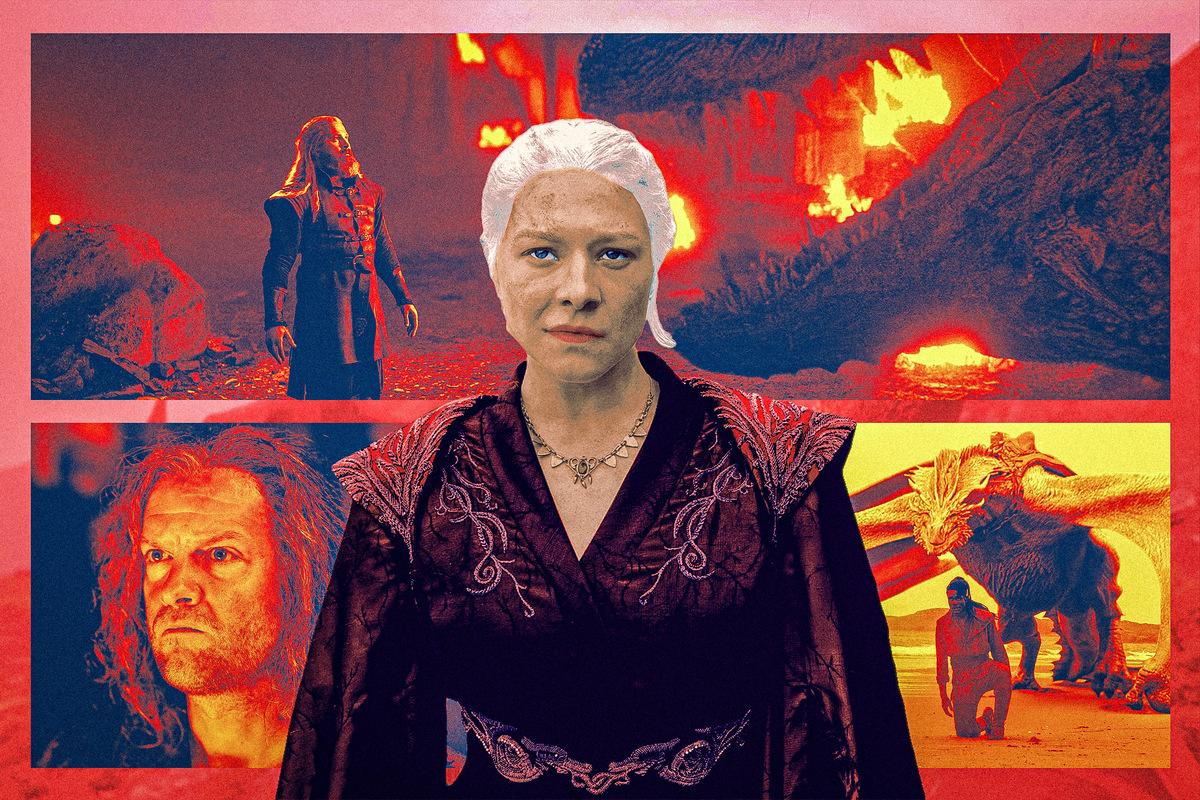‘House of the Dragon’ Season 2, Episode 7 Breakdown: All Your Baseborn Are Belong to Us
In this week’s ‘HotD’ deep dive, we look at bastard bios, missing moms, dragon bonds and dragonkeepers, and more

Jacaerys Targaryen might benefit from a viewing of The Incredibles, as he has a sort of “And when everyone’s super, no one will be” moment in Episode 7 of House of the Dragon’s second season. As a black-haired child whom everyone knows was born out of wedlock, he’s feeling all sorts of ways about Rhaenyra’s new plan to arm smallfolk with dragons. Let’s break down why the queen’s heir is so upset.
Deep Dive of the Week: Cripples, Bastards, and Broken Family Trees
Just like that, this war has been flipped on its head. With Vermithor, Silverwing, and Seasmoke all now mounted, the blacks have a massive dragon advantage. Vermithor is nearly as big as Vhagar, Silverwing is formidable herself, and Seasmoke has combat experience from the battles in the Stepstones. Add those dragons to Caraxes, Syrax, Vermax, and Moondancer, and Rhaenyra has a total of seven fighting-sized winged beasts at her disposal (assuming Daemon and Caraxes would come if called).
Compare that to the greens. Vhagar remains the most fearsome dragon in the realm, yes—but even Aemond knew to turn around rather than face Rhaenyra’s roster of dragons this week. As backup, Aemond has only Dreamfyre, who is ridden by possibly the most docile person in the realm (Helaena), and, in Oldtown, Daeron’s Tessarion, who has only just now “taken to wing.” If Aemond had continued on toward Dragonstone, the blacks could have fought Vhagar six-on-one. Add that lopsided dragon math to the fact that the Riverlands finally joined Daemon, and you have a real tipping of the (literal) scales happening.
Things look so advantageous for Rhaenyra and Co. that some on Team Black are already looking ahead, with Jacaerys wondering about his own succession—and whether it could be contested by these new dragonriders. Jace’s last name is not Targaryen, his hair is not silver, and his dragon is not so intimidatingly large. Plus, basically everyone in the realm believes he’s Harwin Strong’s bastard rather than Laenor Velaryon’s legitimate son, which is easy to believe because it’s obviously true. He’s not wrong to be concerned. Jace gets so heated during his conversation with Rhaenyra that he calls the lowborn “mongrels.” It’s intense—and a bit ugly.
House of the Dragon is pulling a classic A Song of Ice and Fire move in introducing complex motivations and infighting among characters who are nominally on the same side. But as I wrote last season, the topic of bastardy is complicated when it comes to Rhaenyra’s children. Jacaerys, as well as his brother Joffrey, are not Laenor Velaryon’s trueborn children. But neither are they baseborn smallfolk like Hugh or Ulf. There are levels of bastardy in Westeros.
Remember how in Game of Thrones, Jon had the last name “Snow”? This was a stain for him—he was no Stark—but at least he had a last name. Only highborn bastards who are recognized by their fathers get those traditional surnames, which is why Hugh, Ulf, Alyn, and Addam don’t carry the last name “Waters,” as highborn bastards of the Crownlands traditionally do. Furthermore, bastards can be legitimized, and once they are, they carry all the same rights and privileges as their legitimate counterparts—but this opportunity is almost exclusively the domain of those highborn bastards with a father who may have sway with the Iron Throne. Even if they are not legitimized, highborn bastards often train and learn right alongside their siblings, giving them valuable skills. Again, think of Jon Snow.
(And if this is making you curious about who Alys Rivers’s father must have been to make her not just Alys, well, get in line. I have no idea, but I’d love to know.)
Royal legitimization is supposed to wash away all traces of bastardy. In Game of Thrones, Ramsay Snow becomes Ramsay Bolton after King Tommen legitimizes him, and Ramsay inherits the Dreadfort upon his father’s death, just as if he’d been a true Bolton. Jace’s mother is the queen, so he doesn’t need a royal decree—he’s already officially legitimate, and thus ostensibly not a bastard at all. Still, he knows that’s just the letter of the law and that his true parentage could bring his claim to the Iron Throne into question down the line.
Jace is worried about his own succession. But he’s just one side of this coin. The other is Rhaenyra, who is letting smallfolk have dragons. The equivalent would be for the president to let a random citizen on the street have a nuclear warhead. And considering the size of Vermithor and Silverwing, it’s really as if the president gave those street randos the biggest nuclear warheads in the country. This is a wild gambit.
As Bartimos Celtigar’s attitude at the Small Council meeting revealed, others are worried about this. Rhaenyra herself implies that, unlike noble houses, smallfolk don’t have an “ancient fealty” or “honor.” Mysaria, ever the champion of the smallfolk, sees it differently. “They are as like to serve you as highborn lords or ladies. Perhaps more.”
It’s hard to overstate the stigma that bastards face in Westeros. It’s said that bastards—those who are conceived out of wedlock and typically don’t know one or both of their parents—are born of “lust and weakness” and “to betrayal” and that “their nature was wanton and treacherous.” These are traits that are said to stick with bastards their entire lives, regardless of legitimization.
Given all this, you can see why Ulf, Hugh, and so many other smallfolk answered Rhaenyra’s calls for dragonriders. What have Ulf’s white hair and story about being Baelon’s son been worth in his life? The occasional tankard of ale? Is Hugh supposed to spend his whole life being stiffed by the king? These guys have the blood of the dragon, but for many, their silver hair and tales of Targaryen lineage would only prove how untrustworthy and deceitful they are. It’s a raw deal.
Even if the fate of Steffon Darklyn had reached these people, it’s no wonder they chose to brave facing a dragon. Lowborn bastards have the worst lots of just about anyone in Westeros—they have almost no opportunity to prove their station, and many treat them as if they’re would-be criminals. Yet they also know how close they were to being highborn. Just about the only thing that can change their luck? A dragon.
Quick Hits
Alyn and Addam’s mother
It’s too bad that we won’t see Alyn and Addam’s mother on House of the Dragon, despite multiple mentions of her in this episode. Marilda of Hull was (is?) a clever, inventive daughter of a shipwright who raised herself up to become the owner of seven ships by the time of the Dance of the Dragons. I wrote more about her a few weeks back.
Did she have Targaryen ancestry? There’s no way to know—but it doesn’t matter. It’s well established that the Targaryens and Velaryons frequently married (Aegon the Conqueror’s own mother was a Velaryon). So while Corlys himself has no known Targaryen ancestor—and thus neither do Alyn and Addam—it’s reasonable to assume that some of the blood of the dragon made its way into the Velaryon line somewhere way upstream. Speaking of how Addam claimed Seasmoke …
Laenor Velaryon’s fate
It is generally understood that the bond between dragon and rider has a degree of magic to it. How deep that magic goes is unclear, to say the least. But dragons are certainly not horses: No dragon has ever had more than one living rider, and no rider has ever been known to have more than one dragon. But now Addam has claimed Seasmoke, which raises a question: Is Laenor Velaryon dead?
Remember, Rhaenyra’s gambit last season to have Laenor fake his death and run away with Qarl, his lover, does not happen in the books. In Fire & Blood, Laenor and Qarl get into a loud, public argument. Qarl slays Laenor in a market square and escapes on a ship, never to be seen again. Later, Corlys comes and collects Laenor’s body. Given the witnesses present for the killing and the fact that Corlys personally handles the body, there is little room for ambiguity: Laenor dies in the book. That leaves the door open for Addam to claim Seasmoke without challenging our understanding of dragonlore.
But because the show’s deviation allows Laenor to escape across the Narrow Sea, we have to ponder the nature of dragon bonding. In Episode 6, Rhaenyra chooses her words to Steffon Darklyn carefully, saying that Seasmoke is “missing his bond.” If a dragon thinks its rider is dead, is that the same as the rider actually being dead? If a rider abandons the dragon, does that break the bond? Or did Laenor die off-screen in Essos, freeing Seasmoke to forge a new bond? How much does it matter that Addam is Laenor’s half brother and that Seasmoke seemed to choose him instead of the other way around?
I suspect we won’t get answers to these questions. The issue is too complicated, too unclear, too backward-looking. My headcanon is that abandonment is enough to break the bond, and Seasmoke chose his previous rider’s half brother because he missed Laenor. The important thing is that Addam has Seasmoke now.
Hugh Hammer’s mother
We learn some lineage for Hugh this week, as he tells his wife, Kat, that he knew his mother—a pleasure house worker who was an aunt to Viserys and Daemon. Based on that description, it’s almost certain that Hugh’s mother is Saera Targaryen. Here’s what we know about her.
Saera was one of Old King Jaehaerys and Queen Alysanne’s 13 children. While Jaehaerys had an extraordinary reign of peace and prosperity, he was not so lucky with his children—hence the succession crisis toward the end of his life. Saera was one of his most difficult challenges.
Saera was a rebellious child from the moment she was born. Per Fire & Blood, her first word was “no,” and “her ear-piercing wails became the terror of every maid in the Red Keep.” As the ninth-born child, she was not content with what she saw as a lack of attention paid to her (despite the retinue of servants and knights who served her household’s every need). She soon began to act out. She’d fill her sister’s bedchamber with cats, knowing her sister was terrified of them. She once put a hive of bees in her sister’s chamber pot. She even stole all the white cloaks from the Kingsguard and dyed them pink. By age 11, she’d started stealing wine and ale and would arrive everywhere drunk.
Saera was also smart, pretty, and charming, and Jaehaerys and Alysanne hoped she’d grow out of her most immature and mischievous habits. She did not. As Saera entered her teens, talk shifted to whom she would marry. Saera initially wanted to marry another monarch—the Prince of Dorne, for instance—so she could be a queen. But her thinking soon shifted. Fire & Blood says, “Why dream of distant monarchs when she could have as many squires, knights, and likely lords as she desired?” Soon she had three young noblemen and two women who rarely left her side—the six would do nearly everything together. And I mean everything.
Things truly began to turn one night when Saera and her group dared a fool named Tom Turnip—described as “half-witted” in Fire & Blood—to “do the deed” at a brothel in King’s Landing. The prank spilled out onto the streets of King’s Landing and became a scandal. As Queen Alysanne and King Jaehaerys questioned those involved, they learned that one of Princess Saera’s friends was pregnant … and she did not know who the father was. When the king and queen questioned Saera about this, she revealed that she herself had given her maidenhead to “all three” of the boys in her troupe. “They all think they were the first,” she told Jaehaerys and Alysanne. “Boys are such silly fools.” She then suggested she marry all three of them.
Jaehaerys was furious. He sent Saera to her bedchamber—his knights had to drag her there—and fumed over what to do next. Before he and Alysanne could decide on a punishment, Saera attempted to run away from King’s Landing. She made it as far as the Dragonpit—despite not having a dragon—before she was apprehended and returned to the Red Keep. Feeling they were out of their depth with their daughter, Jaehaerys and Alysanne decided to give Saera over to the Faith, sending her to Oldtown to train as a silent sister.
According to Septon Barth, this was supposed to be just a lesson. Jaehaerys and Alysanne planned to pull Saera from Oldtown after a few years of prayer and reflection and return her to court. But once again, Saera had other plans. After a year and a half at Oldtown, she fled the city in the dead of night. This time, she did escape. Alysanne and Jaehaerys had no idea where their daughter was, until a year later, when they got a report that Saera was in the service of a Lysene pleasure garden. “They have made our daughter into a whore,” Alysanne cried. The king’s response? “She always was.”
It’s said that this incident aged Jaehaerys. The realm stopped calling him “the Conciliator” and started more frequently referring to him as “the Old King.” And he never reconciled with Saera, despite his wife’s efforts.
Alysanne wrote letters to her daughter. Saera never responded. The queen also hired agents to watch over her. Saera eventually moved from Lys to Volantis, where she became the owner of her own pleasure house and a wealthy woman. Years passed. Saera never returned home.
But at the Great Council of 101 AC, three men from Essos came forward to press their claim to the throne. They each said they were grandsons of Jaehaerys through Saera—each with a different father. One was said to be “the very image” of Jaehaerys in his youth. Saera, still just 34, did not come to the Great Council, saying, “I have my own kingdom here” in Volantis. The claims of her three bastard sons were quickly dismissed.
We don’t know what happened to Saera from here. Fire & Blood says hardly another word about her, except to note that Jaehaerys sometimes mistook a young Alicent—yes, our Alicent Hightower—for Saera while on his deathbed. Saera may even still be alive during the Dance of the Dragons, as she’d be in her early 60s.
I don’t think Hugh is one of the men who showed up at the Great Council of 101 AC. But it is, of course, very possible—probable, even—that Saera had more than three sons. We don’t have any indication that Hugh is from Essos, and it does seem impossible that Saera had a child while in Westeros, but Hugh could’ve been born in Essos and moved to Westeros while still quite young. Fire & Blood says that Hugh was a “blacksmith’s bastard.” Hugh says in the show that he didn’t know his father growing up, but it’s possible that he was taken in by a blacksmith and moved across the Narrow Sea as a child.
We could speculate further, but the point is that Hugh now has his grandfather’s dragon—the only creature in the realm whose size rivals Vhagar’s.
Why Silverwing chose Ulf
It is sometimes implied that dragons and riders share personality traits. For example, see how Syrax and Seasmoke seemed to imitate their riders in this episode. Maybe this is why Vermithor bent his neck to Hugh. Vermithor is called the Bronze Fury for a reason—you saw it this week—and Hugh also seems to have a fire burning inside him after the death of his daughter and his mistreatment by the royals in King’s Landing. A ferocious dragon for a ferocious rider.
Ulf couldn’t be more the opposite—and neither could Silverwing, which is perhaps why this match worked as well. The drunken blowhard is lucky his stumble through the Dragonmont brought him to the dragon Fire & Blood calls “the most docile” one available.
Silverwing, the longtime mount of Queen Alysanne Targaryen, has never seen combat. But that doesn’t mean she is a stranger to adventure. During their long reign of peace, King Jaehaerys and Queen Alysanne did several tours of Westeros, taking their dragons to wing throughout the continent. When the High Septon died in 54 AC, Alysanne flew Silverwing to Oldtown and fanned the Hightower’s flames with her dragon’s wings as a sort of funeral pyre. A few years later, she flew Silverwing to Winterfell and the Wall. Silverwing refused to cross into the far North (the show changed this event to feature Jaehaerys and Vermithor, at least in Cregan Stark’s telling). There is even a rumor that Silverwing left a clutch of eggs in Winterfell’s crypts.
Alysanne had many adventures—too many to be put down in writing. Fire & Blood says, “Silverwing had carried her to Oldtown, to the Wall, and to a thousand places in between, and Alysanne saw them all as few others ever would, looking down from above the clouds.”
Ulf hardly has the grace or regality of Queen Alysanne. But this old sot’s love of a pint of ale and a good story may have appealed to Silverwing all the same.
What we know about the dragonkeepers
Based on House of the Dragon’s depiction of them, you might think the men and women who tend to the Targaryens’ dragons are part of an ancient Valyrian order. They wear robes, they shave their heads, they speak in High Valyrian—they basically seem like monks. Their devotion to the dragons is almost religious; their dress and mannerisms hint at a spiritual purpose. And to them, it’s an “abomination” for a non-Targaryen to ride a dragon.
However, this is not how the dragonkeepers are depicted in the books. Their roots don’t go back to old Valyria—they don’t even go back to Aegon the Conqueror. The dragonkeepers were created by Old King Jaehaerys after his niece Aerea took Balerion from the Dragonpit and made off with him for more than a year. (I wrote about that dark adventure a few weeks back.) The dragonkeepers weren’t meant to tend to the dragons; they were meant to guard the dragons from people. And per Fire & Blood, the dragonkeepers were no monks. They were basically knights, 77 strong and “clad in suits of gleaming black armor, their helms crested by a row of dragon scales that continued, diminishing, down their backs.” The book repeatedly refers to the dragonkeepers as “guards,” and they wield swords, not staffs.
Why the change? In April 2023, showrunner Ryan Condal talked about the props on the show on the podcast The Stuff Dreams Are Made Of, saying that they didn’t have the capacity to create the elaborate armor described in the books. “We can only make so much armor per season,” he explained. “It’s not really a money thing, it’s a time thing.”
Maybe losing the dragonkeeper armor is how the show freed up the resources for Daemon’s dragon-themed armor, in which case, this feels like a worthwhile change.
The red herring we didn’t get
Fire & Blood tells us that 16 men lost their lives during the Sowing of the Seeds—often called the Red Sowing, once it became the bloody mess depicted in this episode. One was Silver Denys, whom we met briefly this week (assuming preseason casting information about this character’s name was correct). He’s that first guy whom Vermithor rejects and kills. For as cool as the Red Sowing was on-screen, I do wish the show had devoted some time before this scene to a character who doesn’t claim a dragon and thus lose their life in the Sowing. It would have made everything more dramatic. And that character could have been Silver Denys.
Granted, in Fire & Blood, Silver Denys’s story unfolds a bit differently. It’s not Vermithor Denys is trying to claim—it’s Sheepstealer, the wild dragon now hanging out in the Vale. Somehow Denys’s death in Fire & Blood is even more chaotic:
A man called Silver Denys, whose hair and eyes lent credence to his claim to be descended from a bastard son of Maegor the Cruel, had an arm torn off by Sheepstealer. As his sons struggled to staunch the wound, the Cannibal descended on them, drove off Sheepstealer, and devoured father and sons alike.
I have no idea why Denys would claim he’s the grandson of Maegor the Cruel. Not only was Maegor famously impotent—unable to produce any offspring with any of his six wives—he is widely viewed as one of Westeros’s worst kings ever, an absolute tyrant. Just say you’re descended from Jaehaerys or whomever!
The Board Before Us
Daemon has finally brought the Riverlands over to Rhaenyra’s side. The map is starting to look quite nice for the blacks:

Next Time On …
TESSARION.

